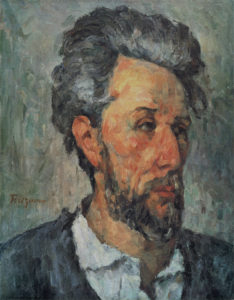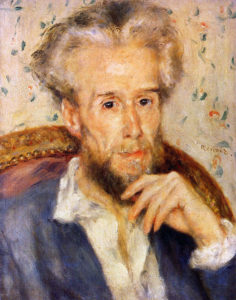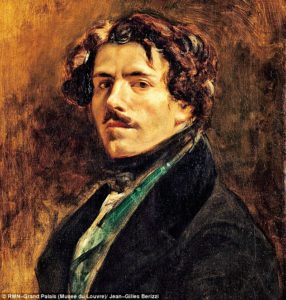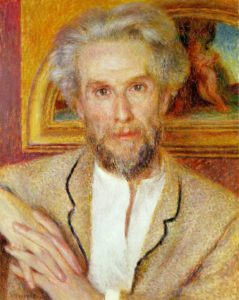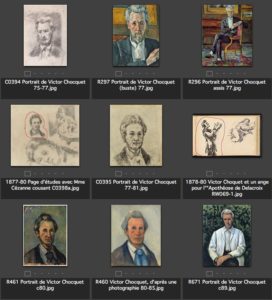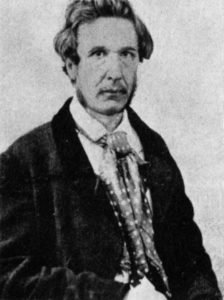R292 – Portrait de Victor Chocquet, 1876-1877 (FWN437)
Pavel Machotka
(Cliquer sur l’image pour l’agrandir)
Le portrait exceptionnel de Victor Chocquet par Cézanne a été peint durant les années 1876 ou 1877. Chocquet est le bienfaiteur modeste et le champion immodeste des jeunes peintres que Renoir avait peint plus tôt et présenté à Cézanne, et qui partageait avec ce dernier une passion pour Delacroix ; la tendresse du peintre pour Chocquet s’exprima dans six portraits réalisés pendant les seize ans de leur amitié.
Quiconque a vu le portrait de Renoir[1], sera incapable de l’oublier en regardant ce premier portrait de Chocquet par Cézanne : alors que le modèle de Renoir est doux et beau, celui de Cézanne est léonin, songeur, ascétique. La puissance de ce portrait ne dépend pas cependant de cette comparaison ; c’est un tableau en soi d’une gravité et d’une substance inhabituelles. Le modèle est vu un peu par en dessous, sa tête, déjà mince, est allongée et son front agrandi au maximum, et son nez court arbore un profil romain prononcé. Il nous rappelle encore plus clairement le portrait de Chopin par Delacroix que le Portrait de Cézanne aux longs cheveux, et nous pouvons soupçonner que la ressemblance était intentionnelle.
La structure de la tête est sans doute surprenante, mais c’est la peinture implacable des cheveux et du visage, et même du col et du fond, qui est si impressionnante ; elle n’évoque pas une lutte –ni avec la ressemblance ni avec un rythme cohérent à trouver – mais plutôt un désir de créer une surface riche et un effet de concentration. La gamme des tons de chair, qui va des jaunes très blancs aux carmins les plus foncés, est remarquable comme l’est le choix des gris bleu, vert bleu, et même des vert olive et violets du fond ; plus on le regarde, plus on se rend compte que l’éclat du tableau est dû à la couleur, à savoir, à l’intensification de la chaleur du visage par un fond complémentaire.
[1] Il est reproduit dans Rewald, vol. 2, p. 204, et dans Goetz Adriani, Cézanne’s Paintings, New York, Abrams, 1993, p. 85, par exemple.
________
Cézanne’s exceptional portrait of Victor Chocquet was painted during the year of intense concentration on the unity of the painting’s surface (roughly 1877). His subject was the modest benefactor and immodest champion of the young painters whom Renoir had painted earlier and introduced to Cézanne, and who shared with Cézanne a passion for Delacroix; the painter’s fondness for Chocquet became expressed in six portraits done over the sixteen years of their friendship. Anyone who has seen Renoir’s painting[1] will be unable to suppress a memory of it when looking at the first Chocquet portrait by Cézanne, below: while Renoir’s sitter is kindly and handsome, Cézanne’s is leonine, thoughtful, ascetic. The power of Cézanne’s portrait does not, however, depend on this comparison; by itself it is a painting of unusual gravity and substance. The sitter is seen from somewhat below, his already slim head elongated and his forehead brought to a high peak, and his quite short nose is given a pronounced Roman profile. We are reminded even more clearly of Delacroix’s idealized portrait of Chopin than we were by Portrait de Cézanne aux longs cheveux, and we may suspect that the resemblance was intended.
But as striking as the structure of the head may be, it is the relentless application of paint to the hair and face, and even to the collar and the background, that is so compelling; it does not suggest a struggle—either with the likeness or with finding a consistent rhythm—but rather a desire to create a rich surface and achieve a concentrated effect. The range of skin tones from the whitest yellows to the darkest crimsons is remarkable, as is the choice of grey-blues, grey-greens, and even olive-greens and violets, in the background; it becomes clear, as one continues to look, that the painting achieves much of its brilliance through color, through, that is, intensifying the warmth of the face by a complementary ground.
[1] It is reproduced in Rewald’s The Paintings of Paul Cézanne, vol. 2, p. 204, and in Goetz Adriani’s Cézanne’s Paintings, New York, Abrams, 1993, p. 85.
Source: Machotka, Cézanne: the Eye and the Mind.
Autre portrait de Victor Chocquet par Renoir :
Autres portraits de Chocquet par Cézanne :
Voir également :

